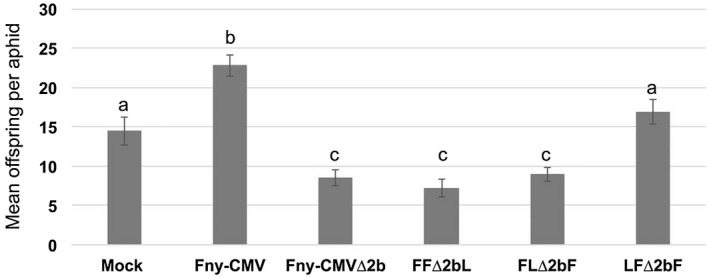Figure 2.

CMV RNA 1 or its gene product, the 1a protein, conditions resistance induction by Fny‐CMV∆2b against aphids. Reproduction of aphids (Myzus persicae) was decreased significantly on tobacco plants infected with the 2b gene deletion mutant Fny‐CMV∆2b. This also occurred on plants infected with the reassortants FF∆2bL and FL∆2bF (which both have RNA 2 molecules that cannot express the 2b proteins encoded by Fny‐CMV or LS‐CMV, respectively, and which both possess Fny‐CMV RNA 1). Aphid performance was not diminished on plants infected with wild‐type Fny‐CMV or the reassortant LF∆2bF, which lacks the ability to express a 2b protein and has the RNA 1 of LS‐CMV. Single 1‐day‐old aphid nymphs were clip‐caged on each plant and their reproduction and survival were monitored for 14 days (n = 28 aphids per treatment group in this experiment). Data marked with different letters (a, b and c) differ significantly (P < 0.05, FDR‐adjusted P‐value). Error bars indicate standard error around the mean. The experiment was done four times independently with similar results seen each time (Table S3). Data for aphid survival and total number of offspring in this experiment can be found in Table S3 (labelled as ‘Experiment 2’). Statistical analysis is listed in Table S4 and described in the Supporting Information.
